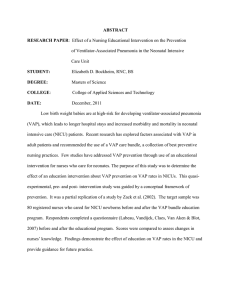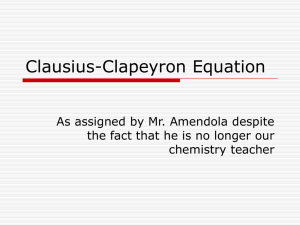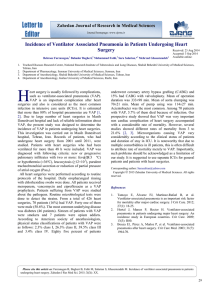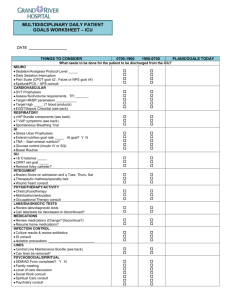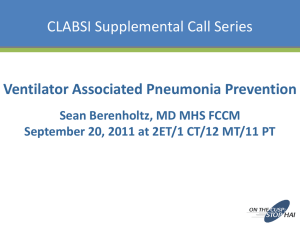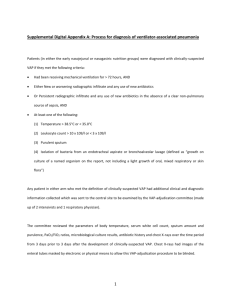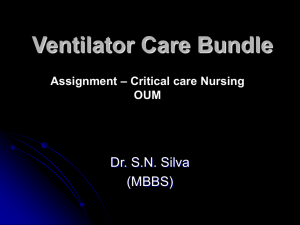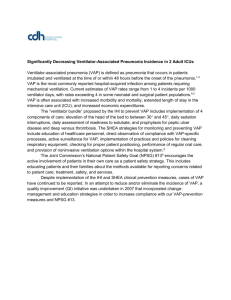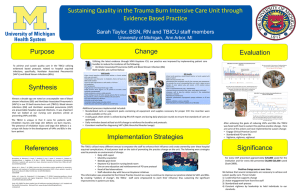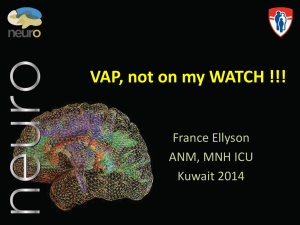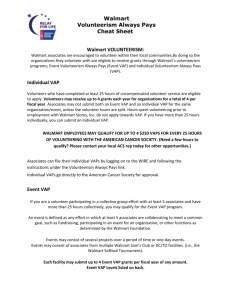Ventilator Associated Pneumonia
advertisement
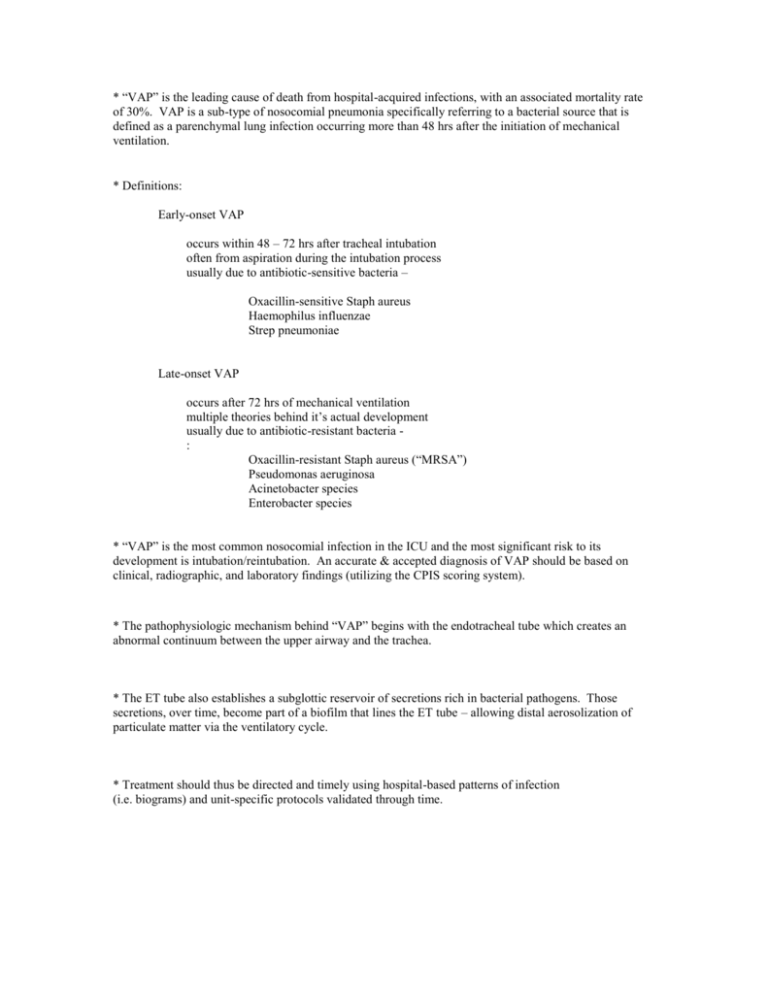
* “VAP” is the leading cause of death from hospital-acquired infections, with an associated mortality rate of 30%. VAP is a sub-type of nosocomial pneumonia specifically referring to a bacterial source that is defined as a parenchymal lung infection occurring more than 48 hrs after the initiation of mechanical ventilation. * Definitions: Early-onset VAP occurs within 48 – 72 hrs after tracheal intubation often from aspiration during the intubation process usually due to antibiotic-sensitive bacteria – Oxacillin-sensitive Staph aureus Haemophilus influenzae Strep pneumoniae Late-onset VAP occurs after 72 hrs of mechanical ventilation multiple theories behind it’s actual development usually due to antibiotic-resistant bacteria : Oxacillin-resistant Staph aureus (“MRSA”) Pseudomonas aeruginosa Acinetobacter species Enterobacter species * “VAP” is the most common nosocomial infection in the ICU and the most significant risk to its development is intubation/reintubation. An accurate & accepted diagnosis of VAP should be based on clinical, radiographic, and laboratory findings (utilizing the CPIS scoring system). * The pathophysiologic mechanism behind “VAP” begins with the endotracheal tube which creates an abnormal continuum between the upper airway and the trachea. * The ET tube also establishes a subglottic reservoir of secretions rich in bacterial pathogens. Those secretions, over time, become part of a biofilm that lines the ET tube – allowing distal aerosolization of particulate matter via the ventilatory cycle. * Treatment should thus be directed and timely using hospital-based patterns of infection (i.e. biograms) and unit-specific protocols validated through time. VAP SCORING SYSTEM: Clinical Pulmonary Infection Score (CPIS) Temperature (C) > or equal to 36.5 and < or equal to 38.4 > or equal to 38.5 and < or equal to 38.9 > or equal to 39 and < or equal to 36 = = = 0 points 1 point 2 points Blood Leukocytes (mm3) > or equal to 4,000 and < or equal to 11,000 < 4,000 or > 11,000 + band form > or equal to 50% = = = 0 points 1 point add 1pt Tracheal Secretions Absence of tracheal secretions Presence of nonpurulent tracheal secretions Presence of purulent secretions = = = 0 points 1 point 2 points Oxygenation: P/F Ratio > 240 or “ARDS” < or equal to 240 and no “ARDS” = = 0 points 2 points Pulmonary Radiography No infiltrate Diffuse (or “patchy”) infiltrate Localized infiltrate = = = 0 points 1 point 2 points Progression of Pulmonary Infiltrate No radiographic progression Radiographic progression (after excluding ARDS & CHF) = = 0 points 2 points = = 0 points 1 point Culture of Tracheal Aspirate Pathogenic bacteria cultured in rare or light quantity, or no growth Pathogenic bacteria cultured in moderate or heavy quantity Same pathogenic bacteria seen on Gram stain add 1 pt = CPIS at baseline involves the first 5 variables. CPIS at 72 hrs includes all 7 variables. A score greater than 6 at baseline or at 72 hrs is considered suggestive of Pneumonia & targeted abx should be continued for a 10 day course. * EMPIRIC TREATMENT FOR VENTILATOR-ASSOCIATED PNEUMONIA: (treatment without positive cultures) BEGIN Combination Therapy: 4th generation Cephalosporin: Cefepime, 1 g IV q 12 hours & a Fluoroquinolone: Levaquin, 750 mg IV/PO q day OR: Antispeudomonal Lactam: Zosyn, 3.375 g IV q 4 hours & a Fluoroquinolone Levaquin, 750 mg IV/PO q day * Consider Vancomycin for clinical suspicion of MRSA (1 g IV q 12 hours – based on Serum Cr). * “Double-coverage” is recommended based upon our patient population and the likely organisms involved. * Empiric therapy should continue for 72 hours – then stopped and “targeted” per C&S. * Antibiotic therapy should always be directed by culture results (identification/sensitivities) and clinical judgement. * Patients MUST also be entered into a Trauma/ICU-VAP Database for tracking and further monitoring via Compliance & QI.
